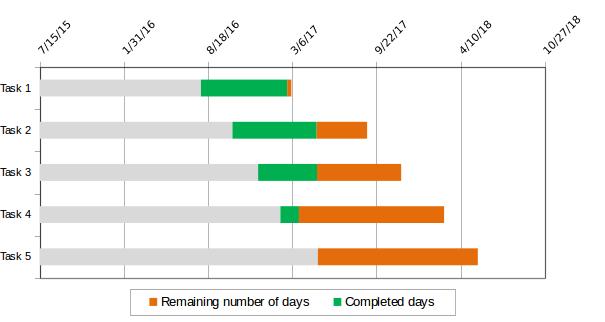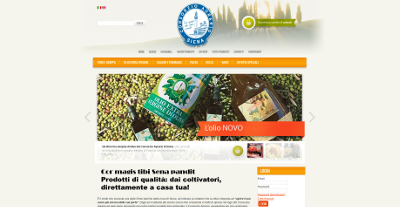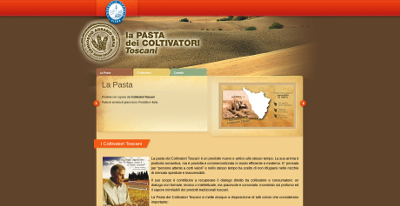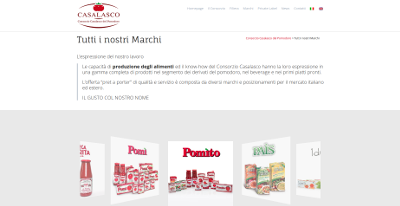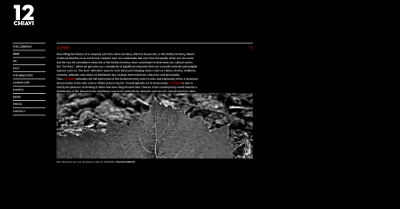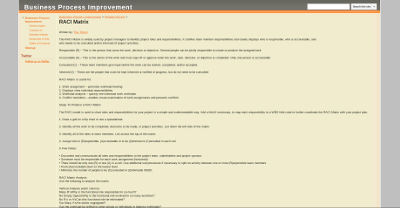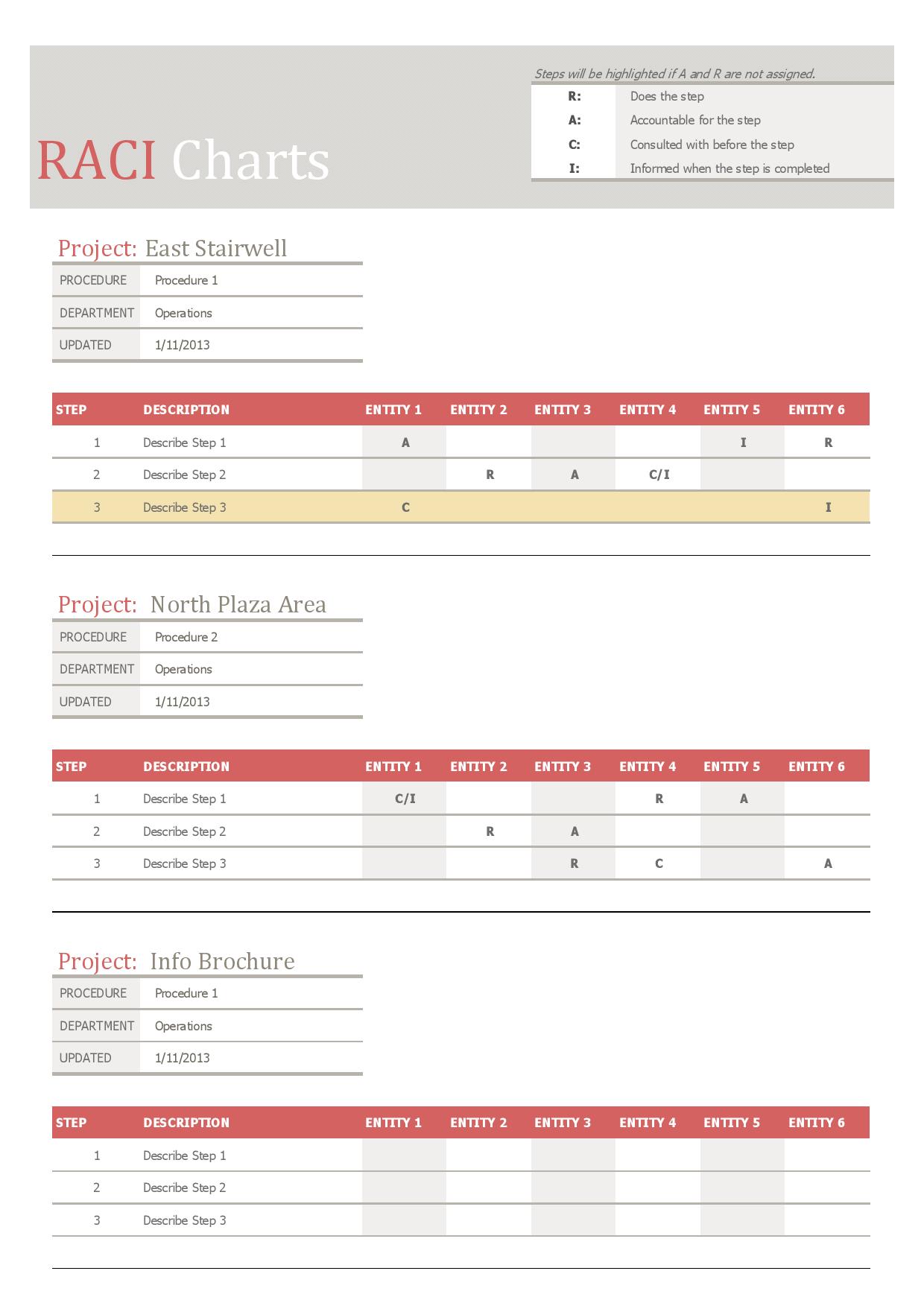Definition of Quality
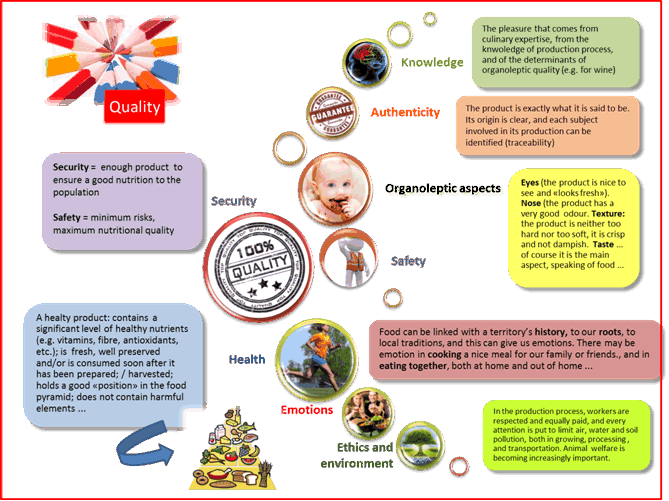
The different dimensions of quality: a little experiment
What we are saying in this section is well known, but a little experiment can make it even clearer.
Just choose 10 different persons (different age, education level, sex ...) and ask them when, according to them, a film is a “good quality” film. You will probably receive very different answers: some will prefer action and special effects, some will pay special attention to music, some will mostly look for romance, some for cultural messages and quotations. The same goes for food: some like ham with a good texture, and some like it soft, some like very mature fruits or tomatoes, some don’t.
“Quality” is a word that has been used so much that it might mean nothing. In the scheme in this page some of the things that may attain to this word are exemplified: we call them the “dimensions” of quality.
Of course, food has to have a good taste, but a growing number of consumers are ready to exchange taste for health: it is less tasty, but more healthy food. And what does “healthy” mean? It may mean that it contains “more” of some things (e.g. vitamins), both because of production methods and freshness and/or because these things have been added. It may mean that it contains “less” of some things that are regarded as unhealthy (e.g. fats, sugar, salt, but also metals, chemical residues, etc.)
Quality is also linked to safety, guarantees, and controls. It can be linked to intellectual pleasure, as well as to emotions (just think of an old variety of fruits and vegetables, to products with a story, to the pleasure of eating together.
Moreover, consumers are increasingly aware that production methods have to respect workers’ rights, animal welfare, and the environment.
Origin is an important quality element, generally speaking because some countries and regions are famous for special food traditions, but also because many consumers prefer to eat local food, because they know it and trust local controls, and also because they want to support local economies. Other reasons: they may meet producers if they want, and they may regard local food as environmentally friendly because long-distance transportation means pollution.
- How would you define “quality”?
- Why must quality be constant and consistent?
- Why is food safety important in a farmers’ activity?
- How could you measure the quality of your output?
Keep in mind
“Quality is never an accident. It is always the result of intelligent effort.”John Ruskin
“Quality means doing it right when no one is looking.”
Henry Ford
“Be a yardstick of quality. Some people aren't used to an environment where excellence is expected.”
Steve Jobs
Quality can be both subjective and objective


Marketing techniques always aim to make sure that no good opportunity to highlight quality features is missed: intrinsic quality has always to become perceived quality. How? By means of promotion and communication, as we have seen in other units.

Watch these videos
Quality has to be consistent
If the quality of what you sell changes from week to week, consumers may associate a certain degree of “risk” to it, as with Russian roulette: will it be good or bad? Will I make a good impression if I bring it to the dinner I have been invited to? So, it is better if the quality is stable.
Things change if – as in the case of wine – it becomes clear to consumers that the change in quality is an important feature of artisanal products, based on raw materials that can change from year to year according to climatic conditions. The best example for this is wine (people want to be connoisseurs and get to know if a special year has been good or bad for a given wine), whereas with olive oil, which have the same characteristics, many consumers prefer blends that make the taste always the same. The difference, once again, lies in communication and consumer acculturation. Of course, this does not mean that communication allows us to sell inefficiency and wrong cultivation practices as if they were quality features – the product is always important
Ways to measure quality
As we said, quality can be measured - special indicators can be identified and measured by means of specific analysis. They can be positive indicators, such as the presence of vitamins and other nutrients, or analyses that show the absence of “evil” elements.
An interesting and now “officially” measurable aspect of the quality of a company is the “Sustainability Report”. The sustainability of a company concerns the exchange of value between a company and its stakeholders, and concerns both environmental and economic, social aspects.
All these aspects can be measured according to specific methods, reported, and communicated.
Quality and authenticity are guaranteed by law
EU schemes operate in the market alongside an increasing number of public and private certification schemes.
For further information on this topic see MODULE 5.
In addition, European marketing standards encourage EU farmers to produce products of given quality, in conformity with consumer' expectations. They allow a comparison of prices between various qualities of the same product. They also ensure minimum quality for the consumer and facilitate the operation of the internal market and the international trade.
They replace the various national standards and are regulated by the "single CMO".
Voluntary certification schemes for agricultural products and foodstuffs provide assurance that certain aspects of the product or its production method, as laid down in a specification, have been observed. They cover a wide range of different initiatives that function at different stages of the food supply chain. They can operate at the business-to-business (B2B) level or at the business-to-consumer (B2C) level. They can make use of logos but, especially at the B2B-level, many do not.
Certification schemes for agricultural products and foodstuffs in the EU range from compliance with compulsory production standards to additional requirements relating to environmental protection, animal welfare, organoleptic qualities, "Fair Trade"…
Scheme owners are equally varied, covering the whole range from farmers and producers, through NGOs, interest groups and retailers, to public authorities. A new inventory compiled for the European Commission in 2010 counted 441 schemes for agricultural products and foodstuffs marketed in the EU.
Geographical indications and traditional specialities
Three EU schemes known as PDO (protected designation of origin), PGI (protected geographical indication) and TSG (traditional speciality guaranteed) promote and protect names of quality agricultural products and foodstuffs.The following EU schemes encourage diverse agricultural production, protect product names from misuse and imitation and help consumers by giving them information concerning the specific character of the products:

Protected Designation of Origin - PDO: covers agricultural products and foodstuffs which are produced, processed and prepared in a given geographical area using recognised know-how.

Protected Geographical Indication - PGI: covers agricultural products and foodstuffs closely linked to the geographical area. At least one of the stages of production, processing or preparation takes place in the area.

Traditional Speciality Guaranteed - TSG: highlights traditional character, either in the composition or means of production.
Exercise
- Choose, among your products, a product that is part of your core business. For example, a certain kind of olive oil, a certain wine, a certain fruit or vegetable, a certain crop.
- For this product, define the key dimensions of quality (that is, the elements on which quality evaluation for this particular product of yours is mostly based. Are there differences between professional evaluation and consumer evaluation (for example, if olive oil “tingles” in the mouth, is it regarded as a healthy or nagging element?). In affirmative cases, consider the point of view of consumers (it is their idea of quality that makes you sell, not yours).
- Be careful to expand all organoleptic dimensions, positive and negative ones: which kind of taste is important? Sweet? Which texture? Which visual aspects?
- Assign a value to each positive dimension: e.g.: too little sweet: 0, sufficiently sweet 1; excellently sweet: 2, too sweet: 3. Keep the same value assigning pattern for all dimensions (too little of something = 0, too much = 3, etc.)
- Do the same for negative aspects, e.g.: absence of some negative aspect = 2, small, acceptable presence = 1; inacceptable presence = 0.
- Now, take two of your products, of which you know that the quality is different, and select 4-5 characteristics that “make the difference”. Assign the correspondent value, for each product, of each characteristic.
- You can now plot your data in a “radar” chart (Excel), like this. It is a method to have an objective evaluation of your products’ quality, and you can also have them evaluated, by means of a questionnaire, by different kinds of consumers.
- In the chart below, which product is better?
| Product A | Product B | |
| Parameter a | ||
| Parameter b | ||
| Parameter c | ||
| Parameter d | Parameter e |
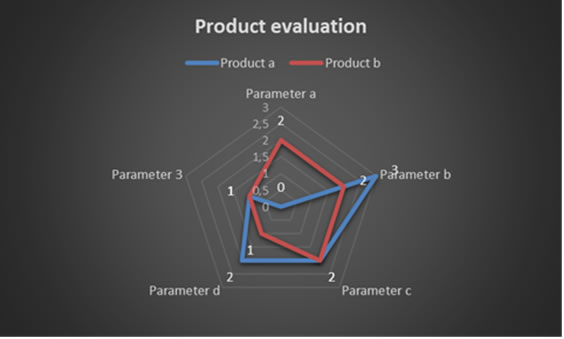
Product oriented and marketing oriented attitude
Once upon a time, the idea of the consumer in the way we know it today did not exist. People produced just the kind and amount of food they needed to cover their primary need of hunger. Varieties available were limited. In that time, everything that was produced had a good chance to be appreciated and chosen. This “special” moment is over, and cannot be duplicated even in developing economies, not only because of demand characteristics, but also because of the structure and strategies of SUPPLY. As soon as a market, or market segment, becomes interesting, many firms are immediately elbowing their way through the crowd to be noticed, informing consumers about the text existence of a wide choice, of different quality levels, and so on.
That is why now we always have to include competition in our business planning.
A farmer with a “product oriented” attitude concentrates on production techniques, which are the basis on which he builds his cost structure, his investment policy, the composition of his staff, and of course his range of products and their packaging (this latter being regarded more as a means of transportation than as a support for communication). His way of doing business tends to be rather rigid facing changes in his environment. A sales oriented farmer believes that if you strive enough you’ll be able to sell what you produce, it is just a matter of engaging. A marketing oriented farmer sees his activity as circular: market needs, which he examines accurately, are the starting point and the final goal. They influence his production, pricing and communication policies, his staff composition, his investments, and a flexible vision of the production process, aimed at seizing, or even anticipating, emerging opportunities.
Look at these links ...
Is product orientation wrong?
No, it is not. Instead, it is very important to preserve and pursue product quality.
Consumers are becoming more and more informed about the different aspects of product quality. Taste is very important, of course, but there are also health issues, and other aspects related to origin, to animal welfare, to ethics and sustainability. Another significant element is service: consumers appreciate everything that helps them make their lives easier (i.e. time saving solutions, easy storage, information on use ...).
What is important is that quality that results from the time and attention we took when producing it is correctly perceived and rewarded. For this to happen, specific aspects of the quality products we offer need to meet specific requirements from the target markets.
It is often said that we are transforming products into solutions.
It is, in fact, important to keep in mind that the value of a product is not confined to its practical use.
For example, an apple can be regarded as a simple fruit, but also as a source of vitamins, a way to “keep the doctor away”, as a childish memory (grandmother’s apple cake ...), as a light snack ..., and according to these different elements, we can organize our offer, our image and our communication strategy.
Another example concerns rice, which is indeed a very common cereal, it may seem to have nothing special, but recent consumption trends have given it a special value because it is ... gluten free, so it has become “a solution for a good gluten free meal”.
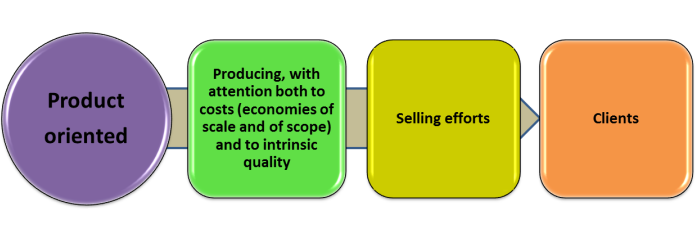
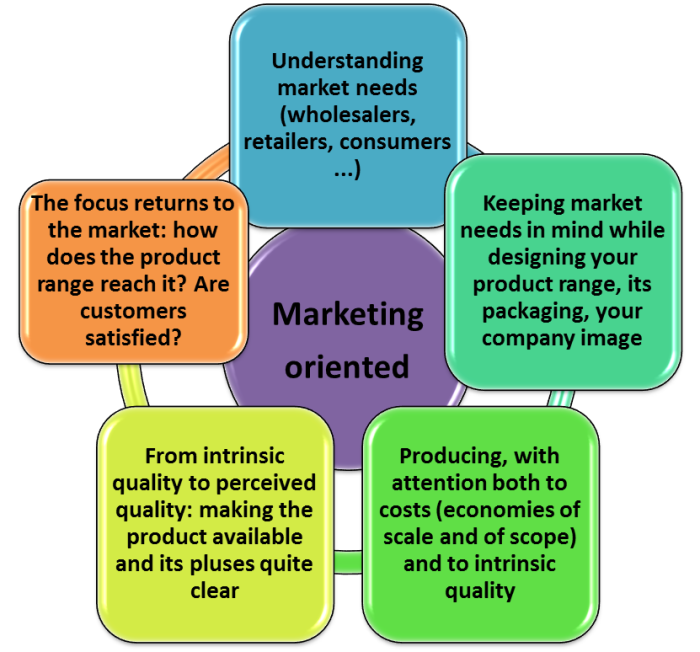
A comparison product and marketing oriented farmers’ behaviours
| Product oriented farmer’s behaviour | Marketing oriented farmer’s behaviour |
|---|---|

Farmer Alex produces beans, choosing the best varieties available, and the latest techniques to maximise the quantity and quality of his production. His staff includes a very good agronomist. He sells his beans to several processing firms.
|
Farmer Christina produces beans, too. Her staff includes not only an agronomist, but also a marketing consultant, who tells Christina about a new trend: an increasing number of consumers are choosing to follow a vegan diet (no products of animal origin), and are always looking for the best alternative sources of proteins. Christina asks her agronomist to select bean varieties with the highest and “better” protein content, and starts raising them. In the same time, she concludes an agreement with a vegan food producer. The result of the partnership is a range of tasty vegan products with a high protein content. |

Farmer Christina is a fruit producer. She has many trees of different kinds, and sells her fruits to a wholesaler. |
Farmer Alex produces more or less the same fruit range as Christina. He always reads agricultural news and once in a while goes to a local supermarket, to see which kinds of fruits are sold there, and how. He even buys these fruits and tastes them, to check if they are better or worse than his. Reading a newsletter, he learns that a local communication campaign will be made in schools, to stimulate fruit consumption. The campaign will be about the link between the consumption of fruit and health. Alex decides to invest in his own, parallel campaign, by means of leaflets, a Facebook page, e-mail newsletters and a stall in the local market, with explicative posters. His claim is a bit funny: “When they see Alex’s fruits, doctors change their job”, and he speaks about his very accurate cultivation and storage methods. He even organises the possibility to buy online and have fruits delivered at home. |

Farmer Alex breeds pigs. He is respectful of the law, and knows everything about fodders. His pigs are sold to the local slaughterhouse.
|
Farmer Christina breeds pigs, too. She learns that consumers are increasingly interested in animal welfare: they feel guilty when they eat the meat of an animal that has suffered. Christina decides to go beyond the law. She starts breeding her pigs in larger spaces, doing everything she can to make their lives pleasant. In the meantime, she does her best to spread information about her initiative in the right places. She even reaches an agreement with a slaughterhouse to reduce the stress and the fear of the animal when transported and slaughtered. In a few months, she has many people visiting her farms to see “Christina’s happy pigs”, and asking where they can buy her meat, so that she even decides to open her own outlet. |
Think and plan: strategic marketing

Where to go, which way to follow, which single steps must be taken
When we prepare our marketing strategy, two things are important to start with: where we are now, and where we want to go. This is not as simple as it may seem, because not all firms know “where they are”. I know where I am with my business when I know things like: what I am selling, to whom (which kind of clients), why what I sell is appreciated, whether my prices are higher or lower than average, whether my prices and costs - combined together - are yielding satisfactory profits, if there are potential clients I have not yet reached and why.
Other things that are important to know:
- are market trends for the products I sell favourable, or is it better to diversify, that is to explore other segments with better trends?
- what are my competitors doing? Are there news strategies I should know about? Are new entries (new competitors) possible?
Once we know where we are, we must decide where we want to go. We do not accept to be brought about by the flow, we want to have a direction, and we want to follow a path to reach our goals. Strategic marketing has to do with identifying and planning that particular path.
Keep in mind
Albert Einstein
"An admirable exercise my friend. Continue it.”
Agatha Christie, Peril at End House
Steve Jobs
Goals and paths
Possible goals concern a better “positioning”, a higher market share, the entry in a new market segment or market channel, internalisation, profits improvement, a better company reputation, and so on. Goals are often interconnected, so we have to take all possibilities into consideration, but then try to be as simple as possible in our planning, to avoid confusion and resource dispersion.
Once one or more goals are set in front of us, how can we reach them? Which road shall we follow?
Positioning, for example, is synthesis of the value that our clients assign to our products and services:
how can we improve it? Consumers and retailers, of course, assign value to what mostly satisfies their needs. It is, therefore, impossible to improve our positioning by offering something nobody is very interested in, or which is regarded as trivial. So the first step of our path to better position our product would be to offer something which can be felt, when bought, as rewarding. Then we have to build the “personality” of our new approach, which is made up of visual, words (messages), the right selling behaviour, the right points of sale, etc.. As you can see, many things have to be decided, and a good decision technique involves trying walking in our clients’ shoes, whether they are wholesalers, retailers, or final consumers. If you were one of them, what would you appreciate most? While designing your path, there’s another thing to be always kept in mind: thinking of the characteristics of your farm, is there the possibility to choose a “special” way, which is not immediately accessible to your competitors? For example, there is an olive producer in Sicily whose olive trees are so well positioned, between mountains and sea, that her plants are hardly ever attacked by diseases and parasites. She choose, therefore, to produce an “absolutely organic oil”, and in doing this she faces much lower costs in comparison with her competitors, because no treatments are needed in her olive grove. She is very lucky in this, but many farms may have special features (location, tradition, know-how) that can be exploited to build their strategic route.
Look at this link ...
The output of this thinking is a strategic document describing our goals for the next 2-3 years and the way we want to follow to reach them. See Module 2 for further info on this topic
Who has the responsibility of each specific decision?
For example, if I want to sell abroad, and take part in all possible fairs, I’ll end up having no budget left to set up a really fantastic booth in my main target country. Keeping a plan helps us focus resources. It is better to keep things simple,to be sure that results can be assessed.
Act: operational marketing
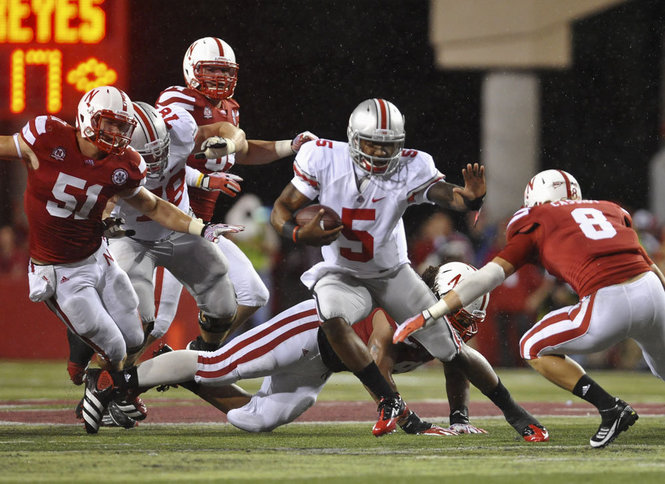
Now we have to put decision into practice, in a rational way
Operational marketing plans can accurately be defined as all actions to be taken. They can be divided into a few main steps:
- put the path recommended by the strategic phase into single actions, and describe each of them in detail
- gather information: ask for quotations (e.g. for logo and packaging design, for radio spots, for a new website, etc.); analyse your human resources and their skills, ...
- assign to each action a person in charge, a “team”, a budget, a timetable, a means of monitoring work progress, and a means of measuring results (e.g. number of contacts, number of “likes” on a social network page, number of visits to the website ...): a comparison of the budget with results will give you a first idea of the effectiveness of the action, as a basis to decide if it is better to go on or to change
- check the consistency and economic feasibility of the whole project
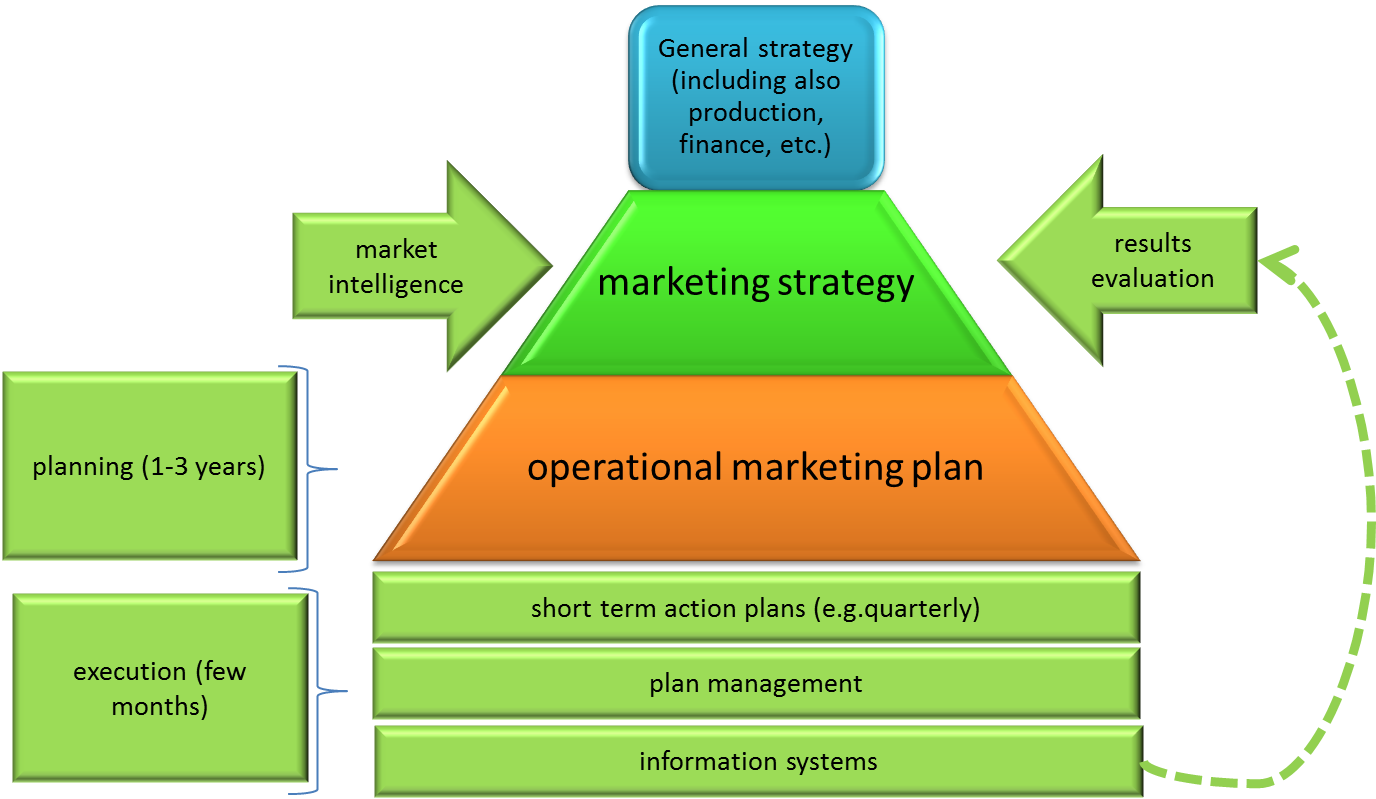
Keep in mind
Mahatma Gandhi
William James
Antoine de Saint-Exupéry
Charles Chaplin
Video on how farmers in mid Wales have diversified in order to stay in business in the wake of foot and mouth disease and BSE
Project Managment methods & tools: WBS, RACI, GANTT
WBS means Work Breakdown Structure, and is an easy way to split up the work to be done into activities, to have the complete picture of what has to be done.
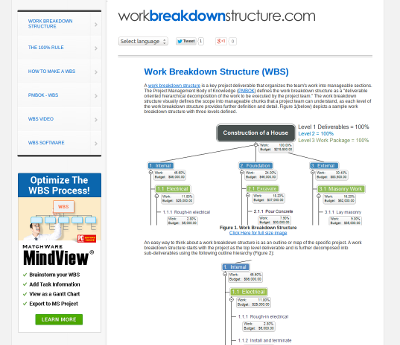
www.workbreakdownstructure.com
Now that you have defined what has to be done, you have to assign specific tasks. In this case, the RACI method can be very useful: it is an easy way to specify, for each task, who is Responsible of doing it (R), who is Accountable (A) for the final decision, who has to be Consulted (C), and who has just to be Informed (I). You can link your RACI with your WBS.
The GANTT chart is a bar chart that illustrates your project’s schedule, making it easy to check work progress and deadlines.
| Start Date | Completed Days | Remaining number of days |
|
| Task 1 | 8/1/16 | 205 | 10 |
| Task 2 | 10/15/16 | 200 | 120 |
| Task 3 | 12/15/16 | 140 | 200 |
| Task 4 | 2/6/17 | 44 | 345 |
| Task 5 | 5/6/17 | 0 | 380 |
